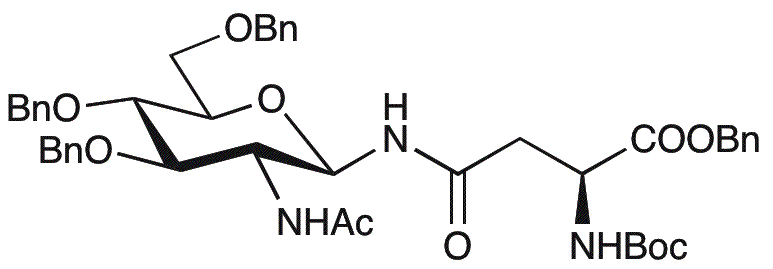Nw-(2-Acetamido-3,4,6-tri-O-benzyl-2-deoxy-b-D-glucopyranosyl)-Na-(tert-butoxycarbonyl)-L-asparagine is widely utilized in research focused on:
- Biotechnology: This compound serves as a key building block in the synthesis of glycopeptides and glycoproteins, which are essential for developing biopharmaceuticals and vaccines.
- Drug Development: Its unique structure allows for modifications that enhance the efficacy and stability of drug candidates, making it valuable in pharmaceutical research.
- Diagnostics: Used in the creation of diagnostic agents, it helps in the detection of various diseases by improving the specificity of assays.
- Food Industry: The compound can be applied in food technology for developing functional ingredients that enhance flavor and nutritional value.
- Material Science: Its properties make it suitable for creating advanced materials, such as biodegradable polymers, which are increasingly important in sustainable development.
General Information
Properties
Safety and Regulations
Applications
Nw-(2-Acetamido-3,4,6-tri-O-benzyl-2-deoxy-b-D-glucopyranosyl)-Na-(tert-butoxycarbonyl)-L-asparagine is widely utilized in research focused on:
- Biotechnology: This compound serves as a key building block in the synthesis of glycopeptides and glycoproteins, which are essential for developing biopharmaceuticals and vaccines.
- Drug Development: Its unique structure allows for modifications that enhance the efficacy and stability of drug candidates, making it valuable in pharmaceutical research.
- Diagnostics: Used in the creation of diagnostic agents, it helps in the detection of various diseases by improving the specificity of assays.
- Food Industry: The compound can be applied in food technology for developing functional ingredients that enhance flavor and nutritional value.
- Material Science: Its properties make it suitable for creating advanced materials, such as biodegradable polymers, which are increasingly important in sustainable development.
Documents
Safety Data Sheets (SDS)
The SDS provides comprehensive safety information on handling, storage, and disposal of the product.
Product Specification (PS)
The PS provides a comprehensive breakdown of the product’s properties, including chemical composition, physical state, purity, and storage requirements. It also details acceptable quality ranges and the product's intended applications.
Certificates of Analysis (COA)
Search for Certificates of Analysis (COA) by entering the products Lot Number. Lot and Batch Numbers can be found on a product’s label following the words ‘Lot’ or ‘Batch’.
Numéro de catalogue
Numéro de lot/série
Certificates Of Origin (COO)
This COO confirms the country where the product was manufactured, and also details the materials and components used in it and whether it is derived from natural, synthetic, or other specific sources. This certificate may be required for customs, trade, and regulatory compliance.
Numéro de catalogue
Numéro de lot/série
Safety Data Sheets (SDS)
The SDS provides comprehensive safety information on handling, storage, and disposal of the product.
DownloadProduct Specification (PS)
The PS provides a comprehensive breakdown of the product’s properties, including chemical composition, physical state, purity, and storage requirements. It also details acceptable quality ranges and the product's intended applications.
DownloadCertificates of Analysis (COA)
Search for Certificates of Analysis (COA) by entering the products Lot Number. Lot and Batch Numbers can be found on a product’s label following the words ‘Lot’ or ‘Batch’.
Numéro de catalogue
Numéro de lot/série
Certificates Of Origin (COO)
This COO confirms the country where the product was manufactured, and also details the materials and components used in it and whether it is derived from natural, synthetic, or other specific sources. This certificate may be required for customs, trade, and regulatory compliance.

